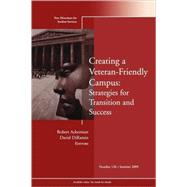
| Editors' Notes | p. 1 |
| Transitions: Combat Veterans as College Students | p. 5 |
| This chapter presents research on how students have handled the transition from combat to campus and uses these personal experiences to shape recommendations on how campuses can address the special needs of this population | |
| The Mobilization and Return of Undergraduate Students Serving in the National Guard and Reserves | p. 15 |
| Personnel in the National Guard and reserves are subjected to periodic activations that are disruptive to their enrollment as students. This chapter reports on research that explains the transitions that students go through when they are called to active duty and later return to student status | |
| Supporting Student Veterans in Transition | p. 25 |
| Relationships between higher education and the military to support students who are veterans have developed over time. This chapter examines how the changing needs of the military have influenced the development of campus-based programs to meet the needs of veterans | |
| Meeting the Needs of Women Veterans | p. 35 |
| The conflicts in the Middle East have changed the role of women in the military, and the impact of the changes are not fully understood. This chapter outlines the issues and suggests ways that campus leaders can help veterans who are women to adjust as they return to civilian life | |
| A Statewide Approach to Creating Veteran-Friendly Campuses | p. 45 |
| Meeting the needs of veterans has become a statewide priority in some places. This chapter explores how an institution of higher education collaborated with state agencies to offer enhanced services to veterans | |
| Ensuring the Success of Deploying Students: A Campus View | p. 55 |
| Developing programs to support student veterans is a campuswide task that involves both faculty and personnel from various administrative offices. This chapter details how, through the efforts of staff members, Appalachian State University gained a reputation for being a veteran-friendly campus | |
| Connections, Partnerships, Opportunities, and Programs to Enhance Success for Military Students | p. 61 |
| Colleges are better able to meet the needs of students when partnerships are formed with other committed service providers. At the University of West Florida, outreach efforts have resulted in programs to address the learning needs of active military personnel | |
| Student Veterans Organizations | p. 71 |
| Military service forms bonds among those who have experienced that unique culture. This chapter examines the processes used to develop student veterans organizations on campuses and the role of those organizations in providing support and connection for those who have had the shared experience of military service | |
| Partnering to Assist Disabled Veterans in Transition | p. 81 |
| One of the ways that society is beginning to respond to the needs of seriously wounded veterans is by connecting them with educational opportunities. An innovative program designed to help wounded veterans access educational opportunities is sponsored by the American Council on Education | |
| Stewards of the Public Trust: Federal Laws That Serve Servicemembers and Student Veterans | p. 89 |
| To effectively serve the needs of student veterans, campus administrators should be aware of the range of government-supported benefit programs that are available. This chapter provides a description of the benefits and explains how to obtain additional information | |
| Index | p. 95 |
| Table of Contents provided by Ingram. All Rights Reserved. |
The New copy of this book will include any supplemental materials advertised. Please check the title of the book to determine if it should include any access cards, study guides, lab manuals, CDs, etc.
The Used, Rental and eBook copies of this book are not guaranteed to include any supplemental materials. Typically, only the book itself is included. This is true even if the title states it includes any access cards, study guides, lab manuals, CDs, etc.